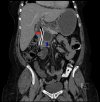Recurrent Pancreatic Pseudocysts Due to Alcohol-Related Chronic Pancreatitis With Double-Duct Sign and Spontaneous Rupture
- PMID: 34345538
- PMCID: PMC8321735
- DOI: 10.7759/cureus.16039
Recurrent Pancreatic Pseudocysts Due to Alcohol-Related Chronic Pancreatitis With Double-Duct Sign and Spontaneous Rupture
Abstract
A 36-year-old female presented with recurrent attacks of alcohol-related acute on chronic pancreatitis complicated by a pancreatic pseudocyst in the head of the pancreas. The cyst was causing obstruction of the common bile duct (CBD) and pancreatic duct (PD) on magnetic resonance cholangiopancreatography (MRCP). She underwent endoscopic ultrasound (EUS)-guided aspiration of the cyst to dryness. A few months later, she presented with epigastric pain and jaundice. MRI pancreas and MRCP revealed a pancreatic cyst in the head of the pancreas, which had grown in size, compressing the CBD and PD with extra and intrahepatic biliary dilatation. There was a recurrence of a new lobulated peripancreatic pseudocyst, which had ruptured resulting in a large collection compressing the right renal capsule. Percutaneous drainage of the ruptured pseudocyst was performed, followed by endoscopic retrograde cholangiopancreatography (ERCP) that revealed distal CBD stricture, which was stented. Her symptoms improved and she was discharged with no further recurrences of obstructive jaundice during the one-year follow-up period.
Keywords: chronic pancreatitis; double duct sign; endoscopy ercp; magnetic resonance cholangiopancreatography (mrcp); pancreatic pseudocysts; spontaneous rupture.
Copyright © 2021, Hasan et al.
Conflict of interest statement
The authors have declared that no competing interests exist.
Figures





Similar articles
-
Endoscopic management of pancreatic pseudocyst: a long-term follow-up.Endoscopy. 2002 Mar;34(3):203-7. doi: 10.1055/s-2002-20292. Endoscopy. 2002. PMID: 11870570
-
Preoperative endoscopic retrograde cholangiopancreatography (ERCP) in patients with pancreatic pseudocyst associated with resolving acute and chronic pancreatitis.Ann Surg. 1989 May;209(5):532-8; discussion 538-40. doi: 10.1097/00000658-198905000-00004. Ann Surg. 1989. PMID: 2705818 Free PMC article.
-
The role of per oral cholangiopancreatoscopy (POCPS) in complicated pancreaticobiliary disease.Acta Med Indones. 2015 Apr;47(2):169-71. Acta Med Indones. 2015. PMID: 26260560
-
Endoscopic approach to acute pancreatitis.Rev Gastroenterol Disord. 2006 Summer;6(3):119-35. Rev Gastroenterol Disord. 2006. PMID: 16957653 Review.
-
[Endoscopic ultrasound-guided transmural cyst drainage (EUS-CD) was effective in a case of pancreatic pseudocyst with obstructive jaundice and duodenal stenosis].Nihon Shokakibyo Gakkai Zasshi. 2010 Sep;107(9):1497-504. Nihon Shokakibyo Gakkai Zasshi. 2010. PMID: 20827047 Review. Japanese.
Cited by
-
Chronic Pancreatitis Complicated by Pseudoaneurysm Causing Gastrointestinal Bleeding.Cureus. 2025 May 29;17(5):e85058. doi: 10.7759/cureus.85058. eCollection 2025 May. Cureus. 2025. PMID: 40585627 Free PMC article.
References
-
- A clinically based classification system for acute pancreatitis. Summary of the International Symposium on Acute Pancreatitis, Atlanta, Ga, September 11 through 13, 1992. Bradley EL 3rd. Arch Surg. 1993;128:586–590. - PubMed
-
- Pancreatic pseudocysts (Part I) Baillie J. Gastrointest Endosc. 2004;59:873–879. - PubMed
Publication types
LinkOut - more resources
Full Text Sources
